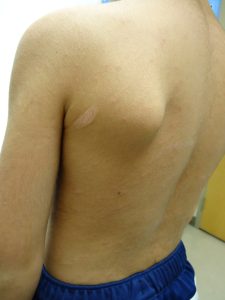Chapter 4: Papulosquamous Disorders
Pitryriasis Rosea
Pitryriasis rosea is an acute, benign eruption that is self-limiting. Peak incidence during adolescence and during spring or fall seasons. It has been connected to Human Herpes Virus 7 & 6 reactivation, with eruption resolves after 6-8 weeks (see viral exanthems as well).
What does it look like?
The so-called herald patch is the first manifestation of the eruption. It appears on the trunk, upper arm, neck or thigh, is several centimeters in diameter, and presents as an erythematous plaque often with a collarette of scale. Subsequently, after 1-2 weeks multiple 0.5 to 2 cm, oval to oblong, red-tan papules with a fine scale. They are characteristically arranged parallel to skin tension lines (Christmas-tree pattern). Mild prodromal symptoms can occur. Plaques are discrete, have peripheral scale, and are generally thinner than in psoriasis.
How is it treated?
No treatment required. Pruritis can be treated with low to mid potency topical corticosteroids.


